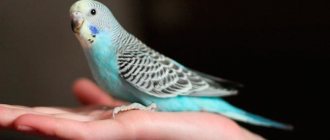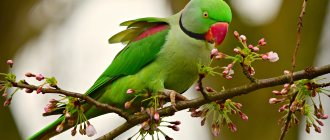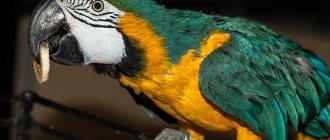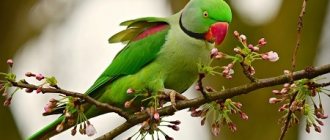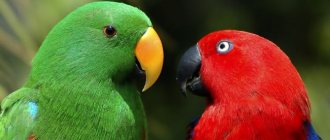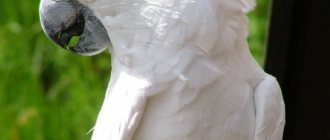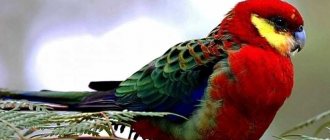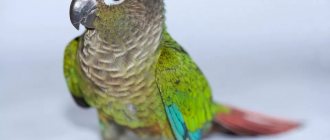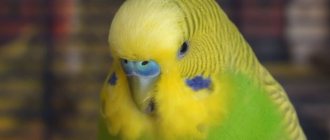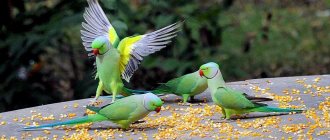Alexandrian parrots are large, well-proportioned birds with a bright, rounded beak and green plumage. During the time of Alexander the Great, they were valued more than strong, healthy slaves and were kept in gilded cages. Now smart and graceful birds have lost their former popularity and are known to a narrow circle of specialists.
Let's find out what Alexander's ringed parrot looks like and what the specifics of its maintenance are.
Appearance and size of the bird
This species of parrot belongs to the genus Ringed and is considered one of its largest representatives. Birds grow up to 45-60 cm including the tail and weigh 250-300 g. They are distinguished by their innate grace and have a proportional body covered with greenish plumage.
Interesting! In Europe, Alexandrian parrots appeared in the 4th century. They came to the continent together with the army of Alexander the Great. Interest in birds arose after they prevented enemies from capturing the greatest commander himself. According to legend, they attacked the invaders and did not allow them to carry out their plans.
According to the generally accepted description, Alexandrine parrots have the following characteristics:
- The head is large, proportional to the size of the body.
- Eyes close set. The iris is colored yellow.
- The beak is massive, bright red, with a well-rounded upper beak.
- The wings are long and strong.
- The tail is long, hanging down.
- Paws are gray, with long claws.
- The feather cover is colored green, the shade of which varies from emerald-pistachio to rich malachite. The tail, back and wings are darker than the belly, back of the head and cheeks. There is a black stripe on the throat of males, just below the beak. The back of the neck is decorated with a red “necklace”. There are burgundy-brown spots on the outside of the wings.
On a note. The approximate age of Alexandrian parrots can be determined by their appearance. Juveniles have a carrot-orange bill, while adults have a bright red bill. And the characteristic “necklace” on the neck of males appears only at 36 months.
Blue-faced Amazon
0
Blue-faced Amazon (lat. Amazona versicolor) - lives exclusively in the Lesser Antilles. This Amazon, like the yellow-headed Amazon, is on the verge of extinction. In 1980, the Blue-faced Amazon was declared the national bird of Saint Lucia. Is under state protection. At this time, only 450 individuals remained in the wild. This is a fairly large bird - up to 43 cm in length.
Character and behavior
The Alexandrian parrot has a good-natured, but very peculiar disposition. He easily gets used to the company of people, but he feels special affection only for one of the family members. If the bird is not in a good mood and is not in the mood to make contact, it may bite painfully. Therefore, when a pet is not inclined to communicate, it is better to leave it alone.
Alexander's ringed parrot is quite curious and can find entertainment on its own. With the help of long claws and a strong beak, it often bites wires and damages furniture. Therefore, the bird should not be left uncontrolled.
Interesting! The Alexandrine parrot is very smart and quickly learns unnecessary things. He is able to open a cage that is not tightly locked and can tear open packages of his host’s food. And especially gifted birds can easily figure out how to unscrew water taps.
Differences from the necklace parrot
Alexandrov ringed belongs to the same genus as the ringed one. It lives in approximately the same areas and at a young age can easily pass for a necklace. However, in comparison with it, the Alexandrian parrot has a number of distinctive features.
- The main part of its body is covered with green feathers. Whereas the necklace can be colored red, blue, blue, white or yellow.
- These birds can be distinguished not only visually, but also by behavior. The necklace parrot is difficult to tame, has no special ability to copy human speech and is not recommended for home keeping.
Necklace parrots
Yellow-headed Amazon
0
The Yellow-headed Amazon (lat. Amazona oratrix) is a very beautiful green-yellow parrot. Found in moist forests and tall deciduous forests of Mexico, Belize, Guatemala and northwestern Honduras. These colorful birds have a body length of 37 to 41 cm. They are classified as endangered. There are about 6 thousand of them left in the wild.
×
Keeping a parrot at home
Alexandria parrots easily adapt to life in captivity. To make the birds comfortable, they are placed in a room with an air temperature of 20-25 degrees Celsius and provided with the correct regime.
For good health, Alexandrine parrots need 12 hours of sleep. Moreover, the time of falling asleep and waking up is not particularly important. To prevent sleeping pets from being disturbed by light, their cage is covered with thick fabric. In this case, it is important to ensure that the material hangs down freely and does not interfere with air exchange.
On a note. Alexander's ringed parrot has a harsh voice and creates a lot of noise. If the pet lives in an apartment, then it must have good sound insulation. Otherwise, neighbors may complain about bird calls.
Arrangement of the cage
The Alexandrine parrot needs a spacious cage made of durable and environmentally friendly materials. The height of his home should be at least 1.5 m, and the width - 2 m. It is better if it has a flat top, since a domed roof often causes injury to the wings.
Important! The Alexandrine parrot's cage must be equipped with a heavy, durable deadbolt. Otherwise, the bird will easily open the lock and start acting up.
Inside the cage there must be:
- feeders for different types of food;
- fruit holder;
- grooved perches;
- toys (vines, rings, etc.);
- holiday house;
- mineral stone;
- drinking bowl
On a note. It is better to attach feeders and drinkers to the bars of the cage. Otherwise, the parrot may turn them over, scattering and spilling the contents.
Care and maintenance
To prevent the Alexandrine parrot from becoming a victim of lice eaters, it is provided with proper care, which boils down to maintaining cleanliness and dryness in the cage. Birds' drinking bowls and feeders are washed daily without the use of household chemicals. The floor in the cage is tidied up at least once a week. And twice a month the birds do a general cleaning of their home.
Alexander's ringed parrot is prone to obesity and needs movement. Therefore, he needs to be allowed out to fly for at least an hour every day. If this is not done, then the bird will not only become overweight, but also the muscles will atrophy.
The Alexander ringed parrot has a good appetite and needs a balanced diet. The basis of the poultry diet should be grain mixtures without granular additives. Of the purchased food, the Alexandrian parrot can be given the following brands:
- Prestige;
- Fiory;
- Rio;
- Padovan.
They are given 60 g per day.
Also included in the poultry diet:
- greenery;
- legumes;
- vegetables (cucumbers, zucchini, beets);
- fruits (apricots, apples, oranges).
Additionally, the Alexandrian parrot can be fed with crumbly porridge and boiled chicken eggs. Occasionally, your pet can be treated to spikelets of millet, nuts and white bread soaked in water.
It is strictly forbidden to feed the Alexandrian parrot:
- honey;
- onions;
- sugar;
- potatoes;
- eggplants;
- raw eggs.
Education and training
Young Alexandrine parrots under the age of 5-6 months are best tamed. Such birds make contact more easily and learn words faster. Although in practice there are cases when old birds suddenly began to speak.
To make Alexandrian parrots less capricious, they begin to be raised from the first days of their appearance in the house. At first, birds may be unsociable and wary. But when they realize that nothing threatens them, they will become more trusting and open.
Important! If an Alexandrine parrot does something wrong, it cannot be scolded. In this case, it will be much more effective to simply ignore the pet. A smart bird will quickly grasp the connection between incorrect behavior and deprivation of communication with its beloved owner and adapt.
At first, the birds are taught to calmly respond to the voice, smell and presence of the owner. And then they move on to hand feeding. When Alexandrine parrots are fully adapted and begin to show a willingness to communicate, they can be taught to speak. To do this, they spend more time with the birds and often repeat the necessary words.
On a note. Alexander's ringed parrots are able to remember up to 10-15 words. Although especially gifted birds can retain up to 100 words in memory. True, this happens extremely rarely.
Lifespan and reproduction in captivity
Alexandria parrots live on average 30-40 years. But not all birds live to this age. Feathered pets often become victims of accidents or get lost after flying out of an open window.
Alexander's ringed parrots breed well in captivity. Birds become sexually mature in the second year of life and are picky about their partners.
- If the male chosen by the breeder is not liked by the female, she will become aggressive and refuse to create a pair with him.
- If the first acquaintance goes well, a clutch of 2-4 eggs will soon appear in the nest.
Only the female is involved in hatching the offspring, and the male takes care of her food all this time.
The chicks appear after 28-29 days and after a month become independent. Over the next 3-4 weeks, the young animals are kept with their parents, and then they are placed in a separate cage.
Family matters
An interesting fact is that a married couple of cockatoos, like swans, are united for life.
The black red-tailed cockatoo nests in the hollows of eucalyptus trees growing near water. The depth of the nest in the trunk can reach two meters. When the female incubates the eggs, the male brings her food.
There are one or two eggs in a clutch, but only one chick survives. The little parrot fledges at the age of 75–96 days, but is fed by its parents for several more months. It becomes an adult only after 4–5 years.
Choosing and purchasing a parrot
It is better to purchase Alexandrian parrots from trusted breeders who value their reputation. This way there will be less chance of becoming the owners of a sick or wild bird. Birds older than 7 weeks but younger than 5 months are ideal for the role of a pet. During this period, the chicks no longer need parental care and easily adapt to new conditions.
Important! You can determine the age of Alexandrine parrots by their eye color. The young have a black iris. At 5-7 months, the birds' eyes become dark gray, and even later acquire a characteristic yellow tint.
When choosing an Alexandrian parrot, it is advisable to ask:
- availability of accompanying documents;
- conditions of keeping young animals and parents;
- behavior and health of the chicks.
Healthy Alexandrine parrots should have clear eyes, beautiful plumage, a clean cloaca and a massive beak without growths. Such birds are quite active and interested in communication.
Alexandrian parrots are quite large and beautiful birds with bright plumage and a cheerful disposition. They adapt well to home keeping and with minimal care will delight their owners with their presence for a long time.
